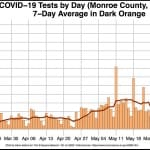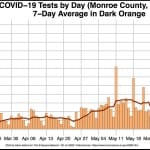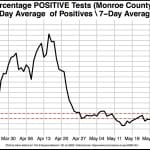COVID-19 Update: Monroe County issues separate order; mayor announces positive antibodies; mask mandate mulled; more tests, confirmed cases




On Thursday, Monroe County’s health officer issued a separate COVID-19 order that is slightly more restrictive than the statewide directive.
The local order starts July 4.
The local health order includes a requirement that businesses post signs encouraging their patrons to wear masks, but does not mandate the wearing of masks.
Local officials are mulling the possibility of following the lead of some other Indiana jurisdictions—St. Joseph, Elkhart and Marion counties—by imposing a requirement that masks be worn when residents are in public. But their preference is to get voluntary compliance.
At their regular weekly press conference on Thursday, pushed up a day due to the July 4 holiday, local officials praised Indiana governor Eric Holcomb’s decision the previous day to pause his Back on Track plan. Holcomb issued a 4.5 version, instead of adopting Back on Track 5.0.
The day before that, Holcomb had extended to July 31 a previous order halting evictions due to non-payment of rent. As a part of the same extended order, utility shutoffs were suspended until Aug. 14.
The new local health order was issued on the same day when Bloomington’s mayor, John Hamilton, announced he had tested positive for COVID-19 antibodies. That’s likely due to having been infected back in April, despite having twice tested negative back then.
Increased testing in Monroe County—from a 7-day rolling average of around 100 a day in the first part of June, to closer to 150 a day in the second half of the month—has come with the highest number of positive cases since the pandemic started.
The current 7-day rolling average is around 6 new confirmed cases a day after staying under 2 from late April to mid-June. The rate of positive tests has nudged upward, but not in a dramatic way.
Local Health Order
The local health order was issued by Monroe County health officer Thomas Sharp. At Thursday’s early afternoon press conference, Sharp ticked through key differences between Monroe County’s directive and the governor’s Back on Track 4.5 plan .
Highlights include a local limit on inside gatherings to no more than 100 people. Outside gatherings are limited to 150 people. Bars have to keep bar top service items—like napkins, straws, limes, lemons and other condiments—protected from customers.
Another highlight of the local order is that by July 8, business have to post a sign at least 8 x 10 inches big at their entrances that “requests patrons wear a face covering while on the premises, in order to protect employees, other customers and those with whom they are in contact.”
Masks
The health order stops short of a requirement that people wear masks when in public. The order includes a recommendation: “Monroe County strongly recommends the use of facial coverings when in public and unable to socially distance, as recommended by the Centers for Disease Control.”
The governor’s Back on Track 4.5 order requires that “state employees, contractors and vendors must wear face coverings in all indoor public areas of state buildings, offices and facilities unless under the age of two or where an existing underlying health condition prohibits the wearing of a face covering.”
During Thursday’s press conference, Monroe County’s health administrator, Penny Caudill said the health officer has the authority to impose a mandate for residents to wear facial coverings when in public. The possibility of issuing a local mandate “has always been on the table,” she said.
Bloomington’s mayor, John Hamilton, added to the point about jurisdictional authority by saying that Bloomington’s city council could enact an ordinance for Bloomington. But the mayor indicated a preference for working on a unified approach with the county government. Hamilton said that it would be preferable to have a national order, given that COVID-19 is a national pandemic.
Caudill said the preference in Monroe County has been to “use the approach of everybody owning their own responsibility.” She would rather get voluntary compliance, instead of mandating it, adding that some people will not wear a mask, no matter what.
Caudill also cautioned that a mask mandate would require additional personnel and labor for enforcement—the existing health orders had already added to the work load of the department, she said.
Caudill pointed to the additional influx of people into the county as Indiana University students return to campus, saying that the county, the city and the university would need to work together on any requirement to wear masks.
Caudill stressed that the six-foot physical distance is the key. Masks are meant to provide some protection with the six-foot distance can’t be maintained, she said.
Testing
The raw number of tests that have been done in Monroe County has increased from month to month and from week to week.
Through April, the rolling 7-day average number of tests was around 25 a day. In May. the 7-day rolling average increased to between 50 and 75 a day. In the first week of June, the rolling average was around 100 each day. By the second week of 7-day rolling average hit 175 tests a day and stayed above 150 for the rest of the month.
The increased number of tests has come with increased numbers of positive tests. On Wednesday, Caudill told The Square Beacon, “We are seeing a correlation between more testing and increased positives, which is no surprise.”
From late April through mid-June, the 7-day rolling average of new confirmed positive tests stayed under 2 per day. In mid-June, coinciding with a one-day spike of 13 cases— which was followed by several days with 6 or more cases—the 7-day rolling average has now increased to more than 6 cases per day.
As a percentage of tests, the number of positive tests in Monroe County has nudged upward a bit, after settling down from the initial percentages in the early phase of the pandemic. Mid-April saw a 7-day rolling average of up to 18 percent positive tests.
The 7-day rolling average percentage of positive tests from mid-May through mid-June was mostly under 2 percent. In the second half of June the 7-day rolling percentage of positives has nudged above 2 percent, getting close to 3 percent.
Caudill characterized the percentage of positives as “stable.” Compared to the rest of the state, Monroe County’s percentage of daily positives is now about half. A week ago, the statewide “moving average” of positive tests was around 4 percent, and has trended upward towards 5 percent.
Caudill told The Square Beacon that the county’s contact tracing nurses are looking at the additional numbers of confirmed positives to see if they related only to increased testing, or are connected to a particular incident or some other factor.
Responding to a question at Thursday’s press conference, Caudill said she had not seen any evidence that the increased numbers of confirmed cases is related to the demonstrations against police brutality that took place in late May through the beginning of June.
Caudill told The Square Beacon, “I do believe that it is a combination of things. People are tired of staying in and want to gather and get out and about. Some are doing that more than others of course. Things are opening up so there will be an increased opportunity to be exposed.”
Caudill said at Thursday’s press conference that she hopes that the testing that is currently being offered locally through the state by OptumServe Health Services will continue.
The OptumServe test center will be closed Friday for the July 4 holiday.
Caudill said that next week, OptumServe will start using longer nasal-pharyngeal swabs—which go farther back into the nasal cavity. Specimens taken with the longer swabs are supposed to deliver more accurate results. Asked as the press conference, if that was likely to increase or decrease the number of positive tests, Caudill was not sure.
Antibody tests
Accuracy of tests came up indirectly at Thursday’s press conference in the context of the announcement a few hours earlier that Bloomington’s mayor, John Hamilton, has tested positive for COVID-19 antibodies.
The city announced in the second week of April that Hamilton’s wife, Indiana University law professor Dawn Johnson, had tested positive for COVID-19. She’s since recovered.
The positive antibody test means Hamilton was likely infected with COVID-19 sometime earlier, in April, when he was experiencing flu-like symptoms. He was tested on April 18 and 21, but those tests turned out negative.
About Hamilton’s two negative COVID-19 tests back in April, Brian Shockney, who is president, of IU Health’s south central region, said during Thursday’s press call that most likely, when Hamilton was tested, he was in fact positive.
Hamilton said during the press conference that he’d had the antibody test done on the order of his personal physician. The test had helped solve a mystery, Hamilton said.
Antibody testing has been done on a random sample of Indiana residents statewide, as part of a study that the IUPUI Fairbanks School of Public Health is doing. Based on Phase 2 of that study, the statewide active infection rate was 0.6 percent, which was a decrease from the 1.7 percent estimated in Phase 1.
The estimate for antibody positivity in Phase 2 was 1.5 percent. That was an increase from 1.1 percent antibody positivity in Phase 1.




Comments ()